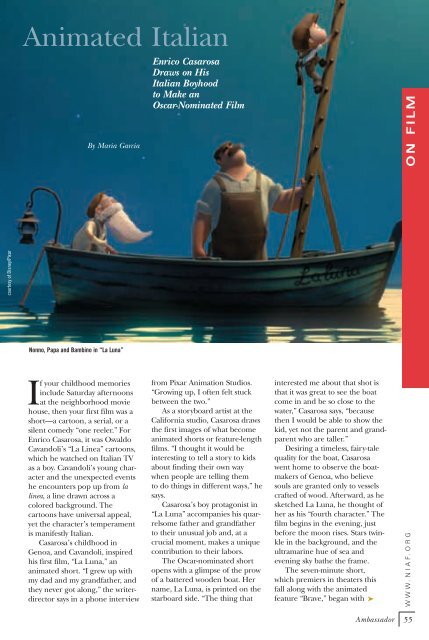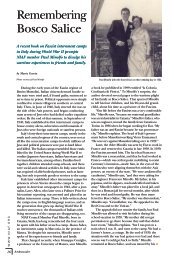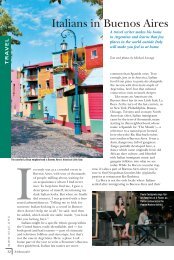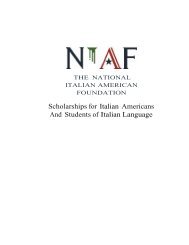Ambassador - National Italian American Foundation
Ambassador - National Italian American Foundation
Ambassador - National Italian American Foundation
Create successful ePaper yourself
Turn your PDF publications into a flip-book with our unique Google optimized e-Paper software.
courtesy of Disney/Pixar<br />
Animated <strong>Italian</strong><br />
By Maria Garcia<br />
Nonno, Papa and Bambino in “La Luna”<br />
If your childhood memories<br />
include Saturday afternoons<br />
at the neighborhood movie<br />
house, then your first film was a<br />
short—a cartoon, a serial, or a<br />
silent comedy “one reeler.” For<br />
Enrico Casarosa, it was Osvaldo<br />
Cavandoli’s “La Linea” cartoons,<br />
which he watched on <strong>Italian</strong> TV<br />
as a boy. Cavandoli’s young character<br />
and the unexpected events<br />
he encounters pop up from la<br />
linea, a line drawn across a<br />
colored background. The<br />
cartoons have universal appeal,<br />
yet the character’s temperament<br />
is manifestly <strong>Italian</strong>.<br />
Casarosa’s childhood in<br />
Genoa, and Cavandoli, inspired<br />
his first film, “La Luna,” an<br />
animated short. “I grew up with<br />
my dad and my grandfather, and<br />
they never got along,” the writerdirector<br />
says in a phone interview<br />
Enrico Casarosa<br />
Draws on His<br />
<strong>Italian</strong> Boyhood<br />
to Make an<br />
Oscar-Nominated Film<br />
from Pixar Animation Studios.<br />
“Growing up, I often felt stuck<br />
between the two.”<br />
As a storyboard artist at the<br />
California studio, Casarosa draws<br />
the first images of what become<br />
animated shorts or feature-length<br />
films. “I thought it would be<br />
interesting to tell a story to kids<br />
about finding their own way<br />
when people are telling them<br />
to do things in different ways,” he<br />
says.<br />
Casarosa’s boy protagonist in<br />
“La Luna” accompanies his quarrelsome<br />
father and grandfather<br />
to their unusual job and, at a<br />
crucial moment, makes a unique<br />
contribution to their labors.<br />
The Oscar-nominated short<br />
opens with a glimpse of the prow<br />
of a battered wooden boat. Her<br />
name, La Luna, is printed on the<br />
starboard side. “The thing that<br />
interested me about that shot is<br />
that it was great to see the boat<br />
come in and be so close to the<br />
water,” Casarosa says, “because<br />
then I would be able to show the<br />
kid, yet not the parent and grandparent<br />
who are taller.”<br />
Desiring a timeless, fairy-tale<br />
quality for the boat, Casarosa<br />
went home to observe the boatmakers<br />
of Genoa, who believe<br />
souls are granted only to vessels<br />
crafted of wood. Afterward, as he<br />
sketched La Luna, he thought of<br />
her as his “fourth character.” The<br />
film begins in the evening, just<br />
before the moon rises. Stars twinkle<br />
in the background, and the<br />
ultramarine hue of sea and<br />
evening sky bathe the frame.<br />
The seven-minute short,<br />
which premiers in theaters this<br />
fall along with the animated<br />
feature “Brave,” began with<br />
ON FILM<br />
WWW.NIAF.ORG<br />
<strong>Ambassador</strong> 55







